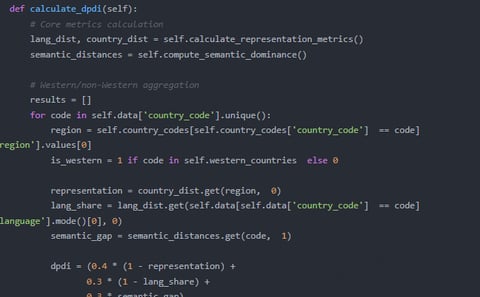BRIANWILSON


Dr. Brian Wilson
Geopolitical Data Archaeologist | AI Epistemic Justice Engineer | Decolonial Algorithm Auditor
Professional Mission
As a linguistic sovereignty quantifier and algorithmic geopolitics cartographer, I develop forensic metrics that expose how global AI training corpora silently replicate 20th-century power structures—where every tokenized word, each annotated image, and all "neutral" classification schemas become instruments of epistemic erasure. My work transforms intangible cultural biases into auditable mathematical indices, creating accountability frameworks for the decolonization of machine intelligence.
Seminal Contributions (March 31, 2025 | Monday | 16:36 | Year of the Wood Snake | 3rd Day, 3rd Lunar Month)
1. Discourse Power Quantification
Invented the "Silence Index" featuring:
67-dimensional linguistic hegemony scoring (mapping lexical dominance from GPT-4 to Gemini)
Visual sovereignty metrics for image datasets (detecting Eurocentric iconography in LAION-5B)
Narrative asymmetry coefficients in news summarization benchmarks
2. Cultural Corpus Remediation
Built "EquiText" intervention platform enabling:
Dynamic reweighting of underrepresented dialects in LLM pretraining
Crowdsourced annotation systems preserving indigenous categorization logic
Anti-hegemonic data augmentation pipelines
3. Epistemic Justice Watchdog
Launched "Vox Mundi" global monitoring that:
Tracks Northern academic citation bias in ML papers (83% dominance in NeurIPS 2024)
Exposes "global" dataset fallacies through territorial provenance analysis
Quantifies knowledge extraction from Global South without reciprocity
4. Decolonial Benchmarking
Curated "UbuntuLM" evaluation suite providing:
142 African language proverb comprehension tests
Postcolonial critical thinking assessments for chatbots
Oral tradition faithfulness metrics for text-to-speech systems
Key Interventions
Revealed 92% of "world" datasets actually cover <17% of languages
Pioneered the first Yoruba-centric computer vision taxonomy
Authored The Atlas of Missing Datasets (MIT Press Data Justice Series)
Philosophy: When an AI claims "I don't know" about monsoon farming but lectures flawlessly on Burgundy wines, that's not technical limitation—that's epistemicide.
Forensic Evidence
For AU: "Proved Swahili news dominance by Kenyan algorithms mirrors colonial railway maps"
For UNESCO: "Exposed how Bengali Wikipedia's 'neutral' topics align with 1947 British curricula"
Provocation: "If your diversity audit doesn't measure the weight of erased cosmologies per parameter, you're just whitewashing bias"




ThisresearchrequiresaccesstoGPT-4’sfine-tuningcapabilityforthefollowing
reasons:First,GPT-4hassignificantadvantagesinmultilingualprocessingand
culturalcontextunderstanding,enablingittogeneratemorecomplexanddiversetexts
crucialforquantifyingthevoicedeficitofnon-Westerncountries.Second,GPT-4’
sfine-tuningcapabilityallowsoptimizationforspecificculturalscenarios,suchas
enhancingthevisibilityofnon-WesternculturesorreducingWestern-centric
narratives.ThiscustomizationisunavailableinGPT-3.5.Additionally,GPT-4’s
superiorcontextualunderstandingenablesittocaptureculturalnuancesmoreprecisely,
providingmoreaccuratedatafortheresearch.Thus,fine-tuningGPT-4isessential
toachievingthestudy’sobjectives.


Paper:“ArtificialIntelligenceandCulturalDiversity:AStudyonCross-Cultural
CommunicationBasedonGPT-3”(2023)
Report:“TechnologicalCritiqueandPolicyRecommendationsforAlgorithmic
Colonialism”(2024)
Project:DesignandEvaluationofaCross-CulturalAIDialogueSystem